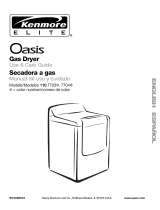
GAS DRYER POWER HOOKUP
Gas Supply Requirements
Explosion Hazard
Use a new CSA International approved gas supply line.
Install a shut=off valve,
Securely tighten all gas connections.
If connected to LP, have a qualified person make sure
gas pressure does not exceed 13" (330 ram) water
column.
Examples of a qualified person include:
licensed heating personnel,
authorized gas company personnel, and
authorized service personnel.
Failure to do so can result in death, explosion, or fire.
Gas Type
Natural gas:
This dryer is equipped for use with Natural gas. It is design-certified
by CSA International for LP (propane or butane) gases with
appropriate conversion.
• Your dryer must have the correct burner for the type of gas in
your home. Burner information is located on the rating plate in
the door well of your dryer. Ifthis information does not agree
with the type of gas available, contact your dealer or call the
phone numbers referenced in the "Assistance or Service"
section.
LP gas conversion:
Conversion must be made by a qualified technician.
No attempt shall be made to convert the appliance from the gas
specified on the model/serial rating plate for use with a different gas
without consulting your gas company.
Gas supply line
• Lengths over 20 ft (6.1 m) should use larger tubing and a
different size adapter fitting.
• If your dryer has been converted to use LP gas, 3/8"LP
compatible copper tubing can be used. If the total length of the
supply line is more than 20 ff (6.1 m), use larger pipe.
NOTE: Pipe-joint compounds that resist the action of LP gas
must be used. Do not use TEFLON_1 tape.
• Must include a shutoff valve:
In the U.S.A.:
An individual manual shutoff valve must be installed within six (6)
feet (1.8 m) of the dryer inaccordance with the National Fuel
Gas Code, ANSI Z223.1. The location should be easy to reach
for opening and closing.
The location should be easy to reach for opening and closing.
A C E
B D
A. 3/8" flexible gas connector C. 1/8"NPT minimum plugged
B. 3/8"pipe to flare adapter tapping
fitting D. 1/2"NPTgas supply line
E. Gas shutoff valve
Gas supply connection requirements
Use an elbow and a 3/8"flare x 3/8"NPT adapter fitting between
the flexible gas connector and the dryer gas pipe, as needed to
avoid kinking.
Use only pipe-joint compound. Do not use TEFLON <eltape.
This dryer must be connected to the gas supply line with a
listed flexible gas connector that complies with the standard
for connectors for gas appliances, ANSI Z21.24 or CSA 6.10.
Burner input requirements
Elevations above 10,000 ft (3,048 m):
• When installed above 10,000 ff (3,048 m) a 4% reduction of the
burner Btu rating shown on the model/serial number plate is
required for each 1,000 ft (305 m) increase inelevation.
Gas supply pressure testing
• The dryer must be disconnected from the gas supply piping
system during pressure testing at pressures greater than 1/2psi.
• Must include 1/8"NPT minimum plugged tapping accessible
for test gauge connection, immediately upstream of the gas
connection to the dryer. See illustration.
• 1/2"IPS pipe is recommended.
• 3/8"approved aluminum or copper tubing is acceptable for
lengths under 20 ft (6.1 m) if local codes and gas supplier
permit.
• If you are using Natural gas, do not use copper tubing.
1®TEFLON is a registered trademark of E.I. Du Pont De Nemours and Company.
















